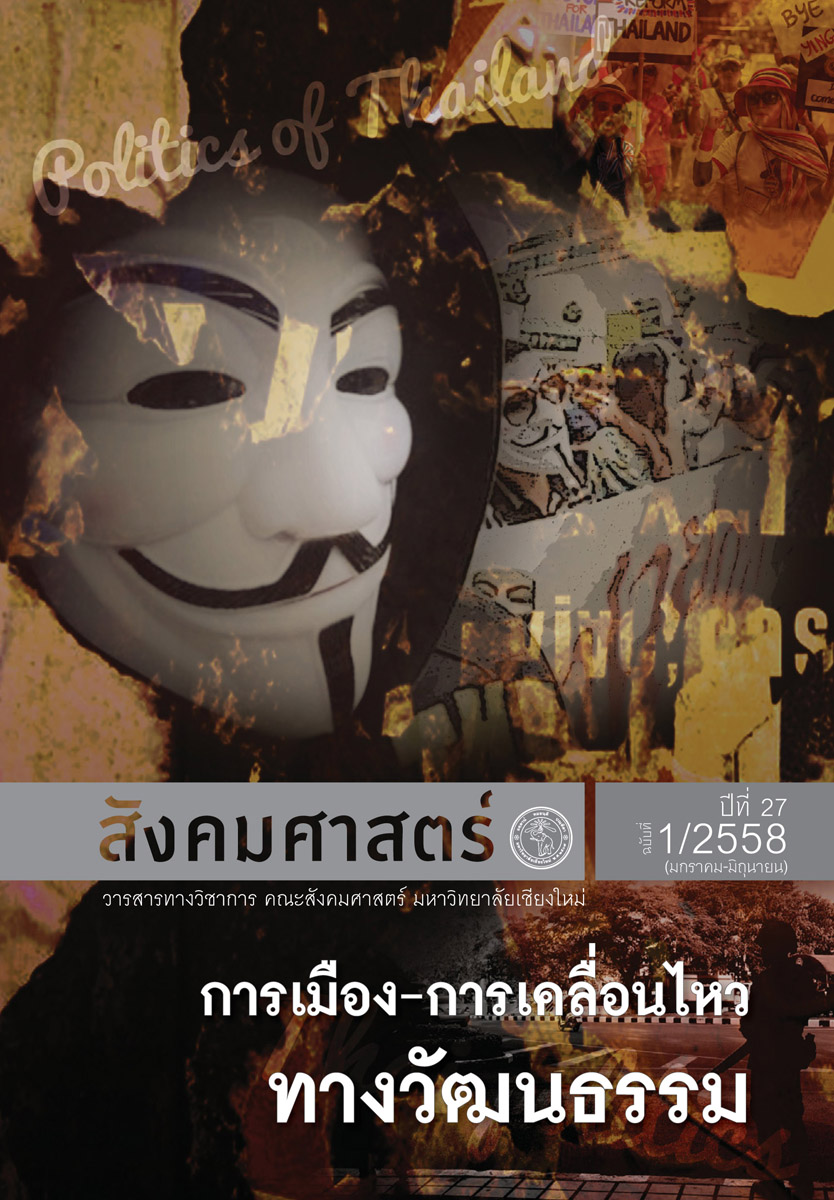The Colored-shirt Politics and the Study of Counter-movement in the Tradition of Social and Political Movement Study
Main Article Content
Abstract
The scholars in the past had largely overlooked the definitions of terms, which led to their confusion and failure to distinguish the differences between movements and counter-movements. Through the case study of the colored-shirt movements arising from the conflicts in the crucial political period, this article aims to engage in the academic debate and elucidate the understanding of movements and counter-movements from the social and political perspectives. With both quantitative and qualitative approaches, this article argues that the red shirts movement is “not” a counter-movement of the yellow shirts movement. Moreover, from my findings, the counter-movements in this transitional period can be classified into two types. Type I refers to the quite freely assembling counter-movements (the Yellow Shirts movement) and Type II refers to the hierarchical counter-movements, which are well organized by the state (the Blue Shirts movement). This article defines the term “counter-movements” relating to the concept about “social change”. Hence, at this point, the social movement is “the democratic movement” and the counter-movement is “the anti-democratic movement”.
Article Details
All written articles published on Journal of Social Sciences is its author’s opinion which is not belonged to Faculty of Social Sciences, Chiang Mai University or is not in a responsibility of the journal’s editorial committee’s members.
References
เก่งกิจ กิติเรียงลาภ และเควิน ฮิววิสัน. 2552. “บทวิพากษ์ ‘การเมืองภาคประชาชน’ ในประเทศไทย: ข้อจำกัดของแนววิเคราะห์และยุทธศาสตร์การเมืองแบบ ‘ขบวนการเคลื่อนไหวทางสังคมรูปแบบใหม่’,” ฟ้าเดียวกัน 7, 2 (เมษายน-มิถุนายน): 120-155.
อุเชนทร์ เชียงเสน. 2554. “กำเนิด ‘เสื้อแดง’ ในฐานะขบวนการโต้กลับ,” ฟ้าเดียวกัน 9, 3
(กรกฎาคม-ธันวาคม): 122-154.
เอกพลณัฐ ณัฐพัทธนันท์. 2555. “รัฐศาสตร์กับแนวทางการศึกษาที่เหมาะสม,” วารสารการเมืองการปกครอง 2, 1 (กันยายน 2554-กุมภาพันธ์): 162-182.
เอกพลณัฐ ณัฐพัทธนันท์. 2556ก. ปฏิสัมพันธ์ระหว่างรัฐ ขบวนการและขบวนการโต้กลับ:กรณีศึกษาการเคลื่อนไหวทางการเมืองของกลุ่มคนเสื้อแดง ตั้งแต่ปี 2549-2553.ปริญญารัฐศาสตรดุษฎีบัณฑิต สาขาวิชารัฐศาสตร์, คณะรัฐศาสตร์ จุฬาลงกรณ์มหาวิทยาลัย.
เอกพลณัฐ ณัฐพัทธนันท์. 2556ข. “ปฏิสัมพันธ์ระหว่างรัฐ ขบวนการและขบวนการโต้กลับ:งานวิชาการตามจารีตการศึกษาแบบขบวนการทางสังคมและการเมืองในระดับสากล(บทสำารวจเบื้องต้น),” วารสารสังคมศาสตร์ มหาวิทยาลัยนเรศวร 9, 2 (กรกฎาคม-ธันวาคม): 7-60.
เอกพลณัฐ ณัฐพัทธนันท์. 2556ค. “พลวัตภายในแนวการวิเคราะห์ขบวนการทางสังคม,”วารสารสังคมศาสตร์ 43, 1 (มกราคม-มิถุนายน): 181-204.
เอกพลณัฐ ณัฐพัทธนันท์. 2557. “ขบวนการมวลชนเสื้อแดงกับการปฏิวัติทางสังคมที่ไม่ถึงจุดสิ้นสุด,” วารสารวิจัยสังคม 37, 2 (กรกฎาคม-ธันวาคม): 45-88.
ภาษาอังกฤษ
Ammar Siamwalla and Somchai Jitsuchon. 2012. “The Socio-Economic Bases of the Red/Yellow Divide: A Statistical Analysis”. In Michael J. Montesano, Pavin Chachavalpongpun and Aekapol Chongvilaivun (eds.), Bangkok May 2010: Perspectives on a Divided Thailand, pp. 64-71. Chiang Mai: Silkworm Books.
Andrews, Kenneth T. 2002. “Movement-Countermovement Dynamics and the Emergence of New Institutions: The Case of ‘White Flight’ Schools in Mississippi,” Social Forces 80, 3 (March): 911-936.
Cox, Robert W. 1996. “Gramsci, hegemony, and international relations: an essay in method (1983)”. In Robert W. Cox and Timothy J. Sinclair (eds.), Approaches to World Order, pp. 124-143. Cambridge: Cambridge University Press.
Cox, Robert W. 2000. “Political Economy and World Order: Problems of Power and Knowledge at the Turn of the Millennium”. In Richard Stabbs and Geoffrey R. D. Underhill (eds.), Political Economy and the Changing Global Order, Chapter 1. Oxford: Oxford University Press.
Cox, Robert W. 1981. “Social Forces, States and World Orders: Beyond International Relations Theory,” Millennium: Journal of International Studies 10, 2 (Summer): 126-155.
Cox, Robert W. 1987. Production, Power, and World Order: Social Forces in the Making of History. New York: Columbia University Press.
Gale, Richard P. 1986. “Social Movements and the State: The Environmental Movement, Countermovement, and Government Agencies,” Sociological Perspectives 29, 2 (April): 202-240.
Goodwin, Jeff and James M. Jasper. 2003. The social movement reader: cases and concepts. UK: Blackwell Publishings. Harvey, David. 2007. A Brief History of Neoliberalism. Oxford: Oxford University Press.
Lo, Clarence Y. H. 1982. “Countermovements and Conservative Movements in Contemporary U.S.,” Annual Review of Sociology 8: 107-134.
McAdam, Doug, Sidney Tarrow and Charles Tilly. 2001. Dynamics of Contention. Cambridge: Cambridge University Press.
McCargo, Duncan. 2005. “Network monarchy and legitimacy crises in Thailand,”
The Pacific Review 18, 4 (December): 499-519.
McCargo, Duncan. 2012. “Two Cheer for Rally Politics”. In Michael J. Montesano, Pavin Chavalpongpun and Aekapol Chongvilaivan (eds.), Bangkok May 2010: Perspectives on a Divided Thailand, pp. 190-198. Chiang Mai: Silkworm Books.
Meyer, David S. and Suzanne Staggenborg. 1996. “Movements, Countermovements, and the Structure of Political Opportunity,” American Journal of Sociology 101, 6 (May): 1628-1660.
Mottl, Tahi L. 1980. “The Analysis of Countermovements,” Social Problems 27, 5 (June): 620-635.
Pichardo, Nelson A. 1995. “The Power Elite and Elite-Driven Countermovements: The Associated Farmers of California during the 1930s,” Sociological Forums 10, 1 (March): 21-49.
Prapart Pintobtang. 2011. What Makes Thai Villagers “Grass Tip” Uprising after the September 19, 2006 Coup? Chiba: IDE-JETRO.
Tilly, Charles. 1964. The Vendée. Cambridge, Massachusetts: Harvard University Press.
Zald, Mayer N. and Bert Useem. 2009 [1987]. “Movement and Countermovement Interaction: Mobilization, Tactics, and State Involvement”. In Mayer N. Zald and John D. McCarthy (eds.), Social Movements in an Organizational Society, 5th printing, pp. 247-272. New Brunswick, NJ: Transaction Publisher.
Zald, Mayer N. 1979. Macro Issues in Theory of Social Movements: SMO Interaction, The Role of Counter-movements and Cross-National Determinants of Social Movement Sectors. Working Paper No. 204. Ann Arbor, MI: Center for Research of Social Organization, University of Michigan.
Zald, Mayer N. and Bert Useem. 1982. Movement and Countermovement: Loosely Coupled Conflict. Working Paper No. 276. Ann Arbor, MI: Center for Research of Social Organization, University of Michigan.


